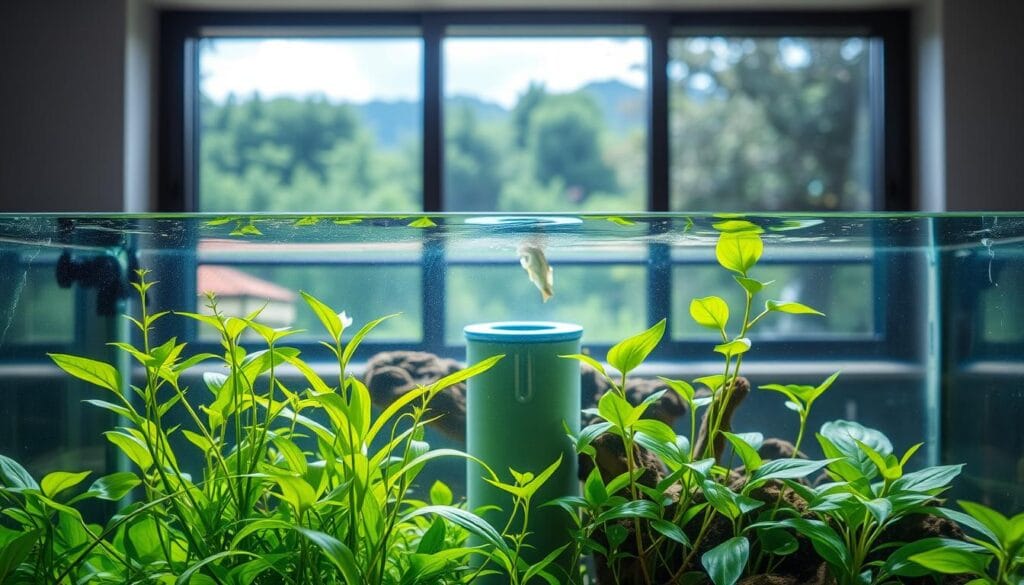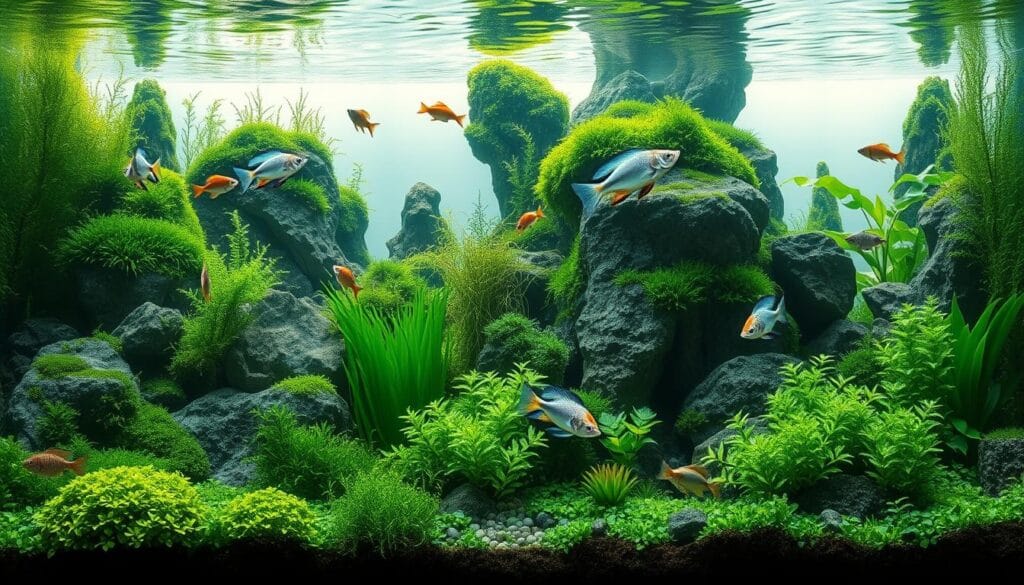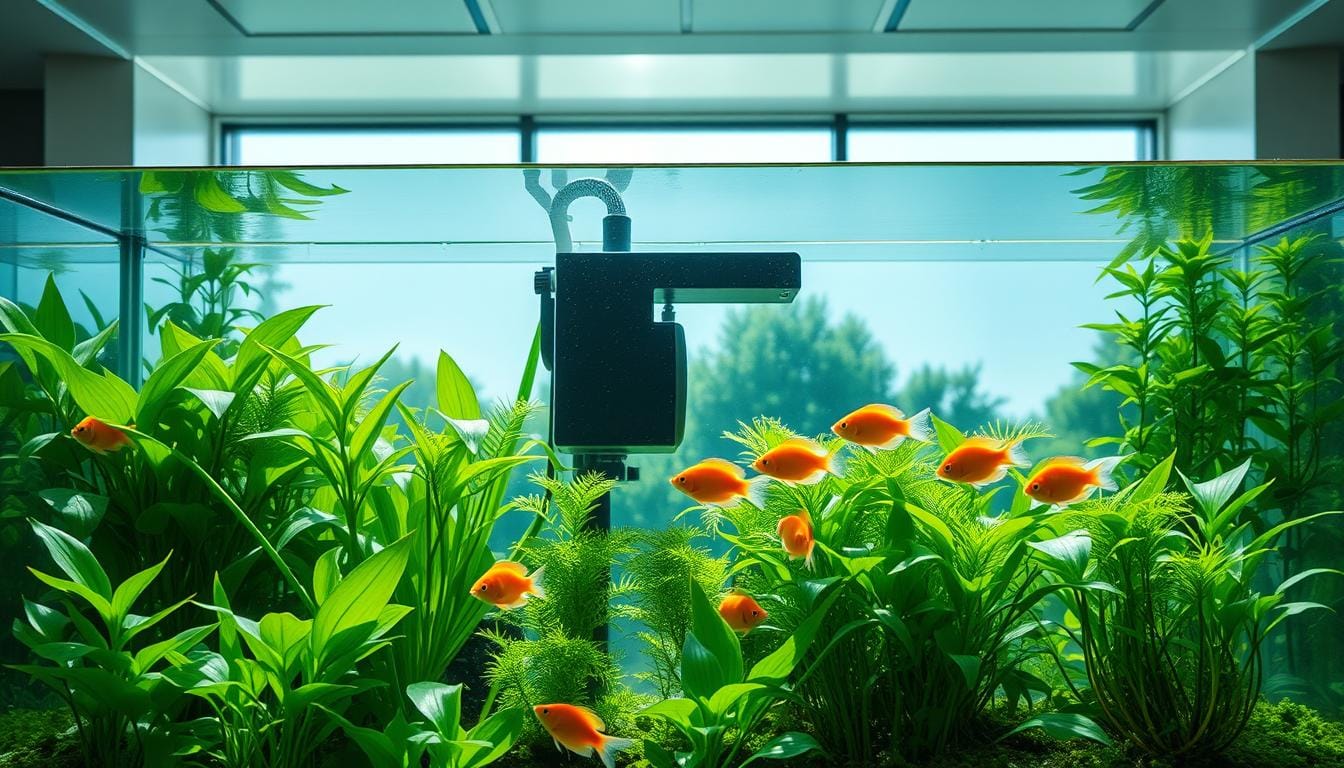As an aquatic pet owner, you know how vital a healthy home is for your pets. A balanced ecosystem in your aquarium or fish tank is key. It all begins with the quality of the water they swim in.
Keeping the water quality just right is a must. Using eco-friendly practices can really help. By going green in your aquatic pet care, you’ll create a happy and healthy space. This space will be good for your pets and the planet too.
Table of Contents
Understanding the Importance of Sustainable Water Systems
Embracing sustainable water systems is key for responsible aquatic pet ownership. It helps create a better home for your aquatic pets.
Why Sustainability Matters for Aquatic Pets
Sustainability is crucial for your pets’ health and life span. Bad water quality can stress, disease, and even kill them. Adopting eco-conscious fish tank setups helps avoid these dangers.
Keeping a sustainable water system means your pets live in a healthy place. This makes their lives better and improves your aquarium experience.
The Impact of Water Quality on Aquatic Life
Water quality is vital for your pets’ health. Bad water can cause stress or serious health issues. It’s important to check and keep your water quality right.
For more tips on setting up an exotic fish tank, check out Exotic Pet Haven. They offer great advice for a thriving aquatic space.
Benefits of Sustainable Practices
Using sustainable practices in your aquarium helps your pets and the planet. Sustainable systems cut down waste and save resources, making your hobby greener.
By choosing sustainability, you join a community caring for our planet. This way of aquarium keeping benefits your pets and the environment.
Choosing the Right Filtration System
The right filtration system is key for your aquatic pets’ health. It keeps the water clean and supports a sustainable aquarium.
Types of Filtration Systems Available
There are many filtration systems to choose from. Mechanical filters catch particles, biological filters help break down waste with bacteria, and chemical filters remove specific contaminants through chemical reactions.
How to Select a Sustainable Filter
When picking a filter, think about its sustainability, efficiency, and upkeep. Choose filters that save energy and cut down on waste. A good filter keeps the water quality high, supporting green practices for your pets.
Consider your aquarium’s size and the fish in it when picking a filter. A filter that’s too small won’t clean well, and one that’s too big might stir up too much water.
Maintenance Tips for Your Filter
Regular care is vital for your filter’s health and longevity. This means cleaning the media, checking for blockages, and replacing parts as needed.
- Clean the filter media as the maker says.
- Look for blockages or damage in the filter.
- Swap out parts when the maker says it’s time.
By keeping up with these maintenance tips, your filter will keep your aquarium healthy and sustainable for your pets.
Water Quality Parameters You Should Monitor
To keep your aquatic environment thriving, it’s essential to monitor several key water quality parameters. Maintaining optimal water conditions is vital for the health and well-being of your aquatic pets. Regular monitoring helps in early detection of any imbalances, allowing for timely interventions.
Key Metrics to Track for Healthy Aquatic Environments
Several water quality parameters are crucial for maintaining a healthy aquatic environment. These include:
- pH levels, which indicate the acidity or alkalinity of the water
- Ammonia, nitrite, and nitrate levels, which are critical for understanding the nitrogen cycle in your aquarium
- Water hardness and alkalinity, which affect the stability of the aquatic environment
As Dr. James Findley, a renowned aquarist, once said,
“The key to a thriving aquarium lies in maintaining a delicate balance between its inhabitants and the water they live in.”
Tools and Kits for Measuring Water Quality
To monitor these parameters effectively, you need the right tools and kits. There are various water testing kits available, ranging from simple DIY kits to sophisticated electronic meters. When choosing a kit, consider the parameters it can measure and its accuracy.
How to Adjust Water Parameters
Once you’ve identified any imbalances in your water parameters, it’s crucial to know how to adjust them. This might involve partial water changes, adjusting the filtration system, or using specific treatments to alter pH or remove toxins. Regular monitoring and adjustments are key to maintaining a sustainable and healthy aquatic environment.
By following these guidelines and staying committed to monitoring and maintaining optimal water quality, you can ensure a thriving environment for your aquatic pets. This aligns with principles of environmentally-friendly aquatic pet care.
Implementing Natural Water Sources
Natural water sources, like rainwater, are chemical-free. They help keep your aquarium water quality high. Using these sources makes your aquarium more sustainable and eco-friendly for your pets.

Using Rainwater and Its Benefits
Rainwater is soft and free from tap water chemicals. It’s perfect for water changes. It reduces stress on your pets from water chemistry changes.
Benefits of Rainwater:
- Lower in chemicals and heavy metals
- Naturally balanced pH
- Reduces the need for chemical treatments
Collecting and Storing Rainwater Safely
To collect rainwater safely, make sure your system is clean. Use food-grade material for storage. Cover containers to stop debris and mosquito breeding.
Key Considerations:
- Regularly inspect and clean the collection system
- Use a first flush device to divert initial runoff
- Test the collected rainwater for quality before use
When to Use Natural Water Sources
Natural water sources are great for water changes or new aquarium setups. Always test the water quality before adding it to your aquarium. This ensures it’s safe for your pets.
Best Practices:
- Monitor the water quality regularly
- Adjust the water parameters as necessary
- Use rainwater in conjunction with other sustainable practices for optimal results
Biofiltration: A Sustainable Solution
Biofiltration uses living organisms to manage water in aquariums. It breaks down waste with beneficial bacteria. This keeps your aquatic pets healthy.
What is Biofiltration?
Biofiltration is a process that uses microorganisms to break down waste in aquariums. It’s key for keeping water quality high and your pets healthy.
As Dr. Ron Miller, a renowned aquaculture expert, once said,
“Biofiltration is a cornerstone of sustainable aquaculture, enabling aquarists to create a balanced ecosystem that thrives with minimal external intervention.”
Benefits of Using Biological Filters
Biological filters in your aquarium have many benefits. They:
- Improve water quality by breaking down waste
- Reduce the need for chemical treatments
- Keep your aquatic pets healthy
- Create a natural and balanced ecosystem
By using biofiltration, you can make a sustainable water system. It’s good for you and your pets.
Installing and Maintaining a Biofilter
To set up a biofilter, pick a good spot and make sure water flows well. Keep an eye on water levels and change some water regularly to keep things right.
Important things to think about when setting up and caring for a biofilter include:
| Parameter | Optimal Range | Maintenance Task |
|---|---|---|
| pH | 6.5-8.5 | Regular monitoring |
| Ammonia | 0-0.25 ppm | Regular water changes |
| Nitrite | 0-0.5 ppm | Regular water changes |
By following these tips and keeping your biofilter working well, you can have a thriving and sustainable aquatic environment.
Aquascaping with Sustainability in Mind
A well-designed aquascape makes your aquarium more beautiful. It also helps keep your aquatic pets healthy. Using eco-friendly materials and sustainable practices creates a thriving ecosystem. This benefits you and your aquatic life.

Selecting Eco-Friendly Materials
The materials you choose for aquascaping are key. Pick natural, non-toxic options that won’t harm your pets or the water. Use rocks, driftwood, and plants from your fish’s natural habitat. These materials make your aquarium look great and help balance the ecosystem.
Eco-friendly materials like recycled glass or sustainably sourced wood add a unique touch. They promote sustainability. Stay away from plastics or synthetic materials that can harm your aquatic environment.
Benefits of Natural Aquascaping
Natural aquascaping improves water quality and cuts down on maintenance. It mimics your fish’s natural habitats, creating a balanced ecosystem. This approach also supports beneficial bacteria, crucial for a healthy aquarium.
Plus, a natural aquascape makes your fish’s environment more stimulating. It encourages natural behaviors and reduces stress. This improves their well-being and makes your aquarium more beautiful.
Tips for Creating a Balanced Ecosystem
To achieve a balanced ecosystem, research your fish’s natural habitats. Choose plants and decorations that fit their needs. Keep an eye on water parameters and adjust as needed to maintain stability.
- Use a variety of plants to create hiding places and reduce stress among your fish.
- Avoid overcrowding your aquarium, as this can lead to water quality issues.
- Regularly clean your aquarium to prevent the buildup of debris and toxins.
By following these tips and adopting sustainable aquascaping practices, you can create a thriving environment. This environment promotes the health and well-being of your aquatic pets.
Water Change Techniques That Promote Sustainability
To keep your aquarium thriving and eco-friendly, using efficient water change methods is key. Regular water changes are crucial for keeping water quality high and your pets healthy.
The Importance of Regular Water Changes
Regular water changes remove waste and excess nutrients that can harm your fish. This keeps your aquarium’s ecosystem balanced. It’s best to change 10-20% of your tank’s water each week, based on its size and biological load.
Benefits of Regular Water Changes:
- Reduces the risk of algae blooms
- Maintains optimal water parameters
- Enhances the health and vitality of your aquatic pets
Methods for Efficient Water Changes
Efficient water changes use the right equipment and techniques to cut down on waste. Using a gravel vacuum to clean the substrate during changes is effective. For more tips on keeping water parameters right, check out https://exoticpethaven.com/how-to-lower-nitrates-in-aquarium/.
Another method is using a water change system that drains and replaces water at the same time. This reduces spills and stress on your fish.
How to Minimize Water Waste
Reducing water waste during changes is vital for sustainable aquarium care. Catching the water drained from your tank in a bucket can be reused for watering plants or other non-potable uses.
“Conserving water is not just about reducing waste; it’s about creating a sustainable practice that benefits both your aquarium and the environment.”
By using these sustainable water change methods, you help create a healthier aquatic environment. You also support green practices for your aquatic pet habitats.
Eco-Friendly Water Additives and Treatments
Using eco-friendly water additives and treatments is key for your aquatic pets’ health. Many products contain harmful chemicals. Choosing sustainable options keeps your aquarium or pond healthy and eco-friendly.
Alternatives to Chemical Additives
There are natural alternatives to chemical additives. For example, peat moss or Indian almond leaves can condition your water. They improve water health without harming your fish or the environment. Learn more about sustainable aquarium practices in the Enviro-One user guide.
How to Use Natural Water Treatments
Follow the instructions when using natural water treatments. Start with small amounts and check your water often. For example, if using a natural conditioner, watch how it changes your water’s pH and clarity. This helps you find the right balance for your aquarium or pond.
Responsible Use of Additives
Even eco-friendly additives need to be used wisely. Always check the labels and look for certifications. Consider the product’s environmental impact. For koi fish pond care, choose safe products for your fish and the ecosystem. Learn more at Exotic Pet Haven.
Choosing eco-friendly water additives helps your pets and the planet. Every small change helps. It’s a step towards a more sustainable future.
Educating Yourself and Others on Sustainability
Learning and teaching others about green aquarium water management is key. By exploring sustainable methods and sharing what you know, you help make the aquatic community greener.
Resources for Learning More
To learn more about caring for your aquarium in a sustainable way, there are many resources. You can find online forums, books, and workshops on eco-friendly aquatic pet environments. Here are some good places to start:
- Online courses on aquatic sustainability
- Books on eco-friendly aquarium practices
- Workshops on sustainable aquatic care
Using these resources can deepen your understanding of sustainable aquarium care.
Engaging with the Aquatic Community
It’s important to connect with the aquatic community to spread the word about sustainable practices. You can join online forums, go to local aquarium clubs, and share your stories. This builds a community and encourages others to adopt eco-friendly practices.
Here are some ways to get involved:
- Join online forums dedicated to sustainable aquariums
- Attend local events and workshops on aquatic care
- Share your knowledge and experiences with others
Promoting Sustainable Practices in Your Network
Sharing your knowledge of green aquarium practices with your friends and family can make a big difference. By inspiring others to adopt these practices, you contribute to a greener future. Here are some ideas to get you started:
| Strategy | Description | Impact |
|---|---|---|
| Share your experiences | Share your successes and challenges with sustainable aquarium practices | Inspires others to adopt similar practices |
| Host workshops or webinars | Organize events to educate others on sustainable aquatic care | Educates a wider audience on best practices |
| Participate in online forums | Engage with online communities to promote sustainable practices | Reaches a broader audience and fosters community engagement |
By using these strategies, you can help spread the word about sustainable aquatic care in your circle.
Future Trends in Sustainable Aquatic Care
The world of aquatic pet care is changing. More focus is on keeping water systems green for pets. As a caring pet owner, you want to help the planet and your pets.
Emerging Innovations
New tech and products are coming for better care. Think advanced filters, green water additives, and eco-friendly decorations. Keeping up with these can help you choose the best for your pets.
Predictions for Sustainable Products
More green pet care items are on the way. Companies will make products that are good for the planet and your pets. You’ll see more options that are both healthy and eco-friendly.
Contributing to Future Developments
You can help shape the future of pet care. Share your stories, give feedback, and support green companies. Together, we can make a better world for aquatic pets.

